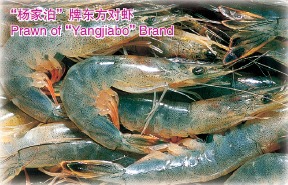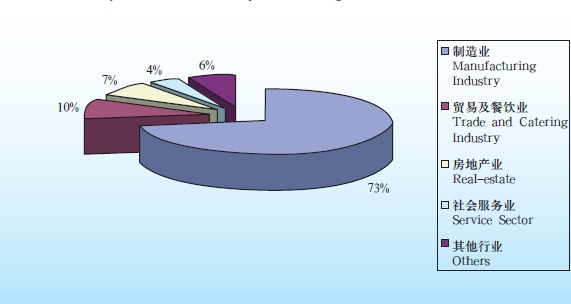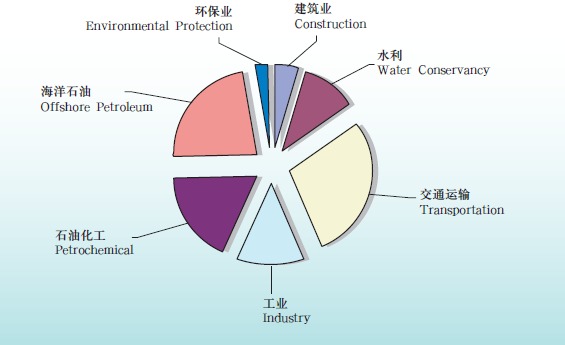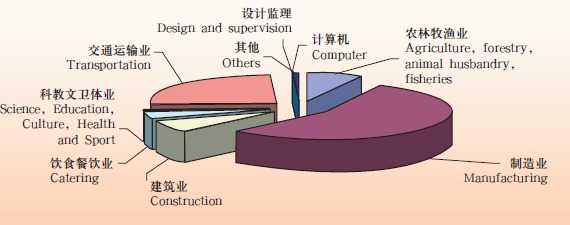(i) GDP Data
In 2005, GDP of Tianjin reached 369.762 billion yuan, with per capita GDP of US$ 4,322. The proportions of the primary, secondary and tertiary industries were 3 percent, 55 percent and 42 percent respectively.
Growth of GDP from 2000 to 2005 in Tianjin

(ii) Resources, Agriculture and Industry
Proportions of Three Industries

Natural Resources
As an industrial and commercial metropolis, Tianjin has a highly-developed economic level, as well as the prominent advantage in natural resources. The first are the rich resources of oil and natural gas. Bohai Oil Field and Dagang Oil Field both serve as priority oil and natural gas fields in China, which produced 17.83 million tons of crude oil and 880 million cubic meters of natural gas in 2005. The second are rich sea salt resources. With a coastline of 153 km long, Tianjin has the most famous sea salt producing area in China-Changlu Saltern, with the annual production of 2.3 million tons of crude salt, occupying 10 percent of the total of China. The third are abundant metal and nonmetal mineral resources. There are more than 10 different kinds of metal mineral resources in Tianjin like chamber site, manganese, gold, tungsten, molybdenum, copper, zinc and iron and various nonmetal mineral resources including cement limestone, barite, stromatolite, marble, natural stone, violet sand clay soil, Maifan Stone, etc. The fourth are plentiful geothermal resources. The geothermal resources in Tianjin are characterized by shallow deposit place and fine water quality with the total geothermal water reserves of 110.36 billion cubic meters. This geothermal source is the largest medium-and-low temperature geothermal field ever discovered in China. The fifth are mass coastal beach lands. Tianjin covers an area of 1,191,900 hectares in total, including 138,000 hectares of unused land. In the coastal region along the lower reaches of Haihe River, there is a piece of 1,214 square km of saline-alkali soil to be developed. With the convenience in transportation and low expense in development, there is much room for this piece of land to be used for ecology preservation and construction.
In addition, Tianjin has great water resources. This city is located in the lower reaches of Haihe River, where its five great tributaries, South Canal, North Canal, Ziyahe River, Daqinghe River and Yongdinghe River converge and flow into the sea. 19 first-class river courses pass by Tianjin, totaling 1,095 km long, and so do 79 second class river courses with a total of 1,363 km long. There are 1,061 deep aqueducts with the total length of 4,578 km. The complete systems of flooding prevention, drainage,irrigation and power generation have been constructed.
Industry



Tianjin is the cradle of China's modern mechanic industry and textile industry, and many products and original inventions in many industries in China first came into being in Tianjin, such as mailing, bicycle, watch, television set, camera, etc. After years of development, Tianjin is no longer dependent solely on traditional industries for growth; instead, it is adopting a new industrial pattern that depends on backbone industries and new & hi-tech industries, gradually forming six dominant industries namely electronic information, automobile, metallurgy, chemical, biotechnology & modern medicine, and new energy & environmental protection. In 2005, Tianjin achieved the gross industrial output of 716.96 billion yuan, among which, the weight of the six dominant industries in the city's all industries was 72%, and that of new & hi-tech industry was 32%. The manufacturing industry of electronic information products has become the first dominant industry in Tianjin.


Major Industrial Product Output in 2005


Proportions of 6 Dominant Industries

Service Industry
In 2005, the service sector (the tertiary industry) in Tianjin realized the added value of 153.41 billion yuan, including 22.7 billion yuan in transportation, warehousing and post sector with the proportion of 15%, 43.6 billion yuan in wholesale and retail sector with the proportion of 28%, 7 billion yuan in accommodation and food service sector with the proportion of 5%, 15.9 billion yuan in financial sector with the proportion of 10%, and 12.9 billion yuan in real estate sector with the proportion of 13%.
Agriculture

In 2005, Tianjin achieved the gross agricultural output value of 23.834 billion yuan, with the agricultural structure being deepened and the construction of agricultural gardens and infrastructure significantly being enhanced. The proportion of aquaculture in the gross agricultural output value reached 58 percent, economic crops occupies 57% in the total crops planting area, and 70% of farmers have realized agricultural industrialization.

Tianjin is rich in many famous agricultural products and by-products with outstanding quality, including the traditional export commodities such as Xiaozhan Rice (local rice in Tianjin) and red beans, the four famous vegetables in Tianjin, i.e. Shawo green turnips, Qingmaye Chinese cabbages, onions with yellow cover and leeks with big green sprouts, Tianjin Chinese chestnuts, Tianjin pears and muscat grapes under the brand of" Cha Dian", which are all well known to both China and foreign countries. Tianjin yields over 150 varieties of famous aquatic products, such as cutlass fish, prawn, purple crabs, and icefish (Salangidae). What is more, the cucumber planting technology studied out by Tianjin Agricultural Research Institute gains a good reputation.

Output of Major Agriculture Products in 2005

(iii) Commercial Data
Import and Export
In 2005, the total import and export volume in Tianjin was US$ 53.387 billion, among which the total export was US$ 27.415 billion. The gross export volume of common trade amounted to US$ 9.083 billion, taking 33.1% of the total export volume in Tianjin; and the gross volume of processing trade was US$ 16.754 billion, occupying 61.1%. The structure of export commodities has been further optimized; the export volume of electromechanical products ranked fourth in China, which was US$ 18.5 billion, occupying 67.5% of the total export volume, and the export volume of hi-tech products reached US$ 12.47 billion, occupying 45.5% of the total export volume in Tianjin. The commodities with large export volume include mobile phones and relevant components and parts, electrical appliances and electronic products, computers, motors and electric generators, etc.
Proportion of Hi-tech Products in Export Volume in 2005

Proportion of Electromechanical Products in Export Volume in 2005

Geographical Distribution of Export Market Shares in 2005

Growth Rate of Export Trade from 2000-2005

Comparison Between Tianjin's Foreign Trade and GDP

Utilization of Foreign Investment
In 2005, there were 1,309 projects with direct foreign investment in Tianjin. The accumulative utilization of direct foreign investment reached US$ 7.323 billion, and the actual utilization of such investment was US$ 3.329 billion. In the same year, there were 379 newly approved projects whose foreign investment exceeded US$ 5 million.
Countries and Regions Whose Investment in Tianjin Ranked Top Ten from 2000-2005

By 2005 end, foreign-invested enterprises with approval certificates have accumulated to 18,401, contracted foreign investment totaled US$ 58.213 billion, and actualized foreign investment reached US$ 0.341 billion. Businessmen from 110 countries and regions have invested in Tianjin. In order of contracted foreign investment volume, the top 10 countries and regions are Hong Kong, America, Japan, Virgin Island, South Korea, European Union, Taiwan, Singapore, Cayman Island, and Australia. Among top 500 multinationals, 114 have established foreign invested enterprises like Motorola, Samsung, Toyota, LG, Semiconductor Manufacturing International, Novo Nordisk, Rohm, Nestle, Kumho Tire, Tinghsin Group, etc. Most foreign investment goes to manufacturing projects, which accounts for 63.77% of the total actualized foreign investment, followed by the 33.88% of investment in tertiary industry.
Major Industries Actually Used Foreign Investment in 2005

In 2005, foreign-invested enterprises in Tianjin realized US$ 394.729 billion sales revenue, US$ 22.022 billion export, US$ 25.775 billion profit, and US$19.022 billion tax. Favorable ROI and business opportunities have driven foreign-invested enterprises to make more investment and issue more stocks.
Economic Cooperation with Foreign Partners and Technology Introduction
In 2005, 907 contracts of foreign contracted projects, design, consulting and labor services were signed, with the contract volume of US$ 432 million and the turnover of US$ 320 million; 13,100 people were sent abroad to provide labor services by year end; 75 new enterprises were established overseas (including 54 manufacturing enterprises) with the total investment of US$ 50.4883 million, among which US$ 43.7154 million was invested by the Chinese side. The main fields of investment cover chemical industry, pharmacy, building materials, food, garment, etc.
Employment Structure of Persons Sent Abroad at the End of the Contracted Term by the End of 2005

By the end of 2005, the accumulated value of contracts of foreign contracted projects, labor services, design and consultation amounts to US$ 3.716 billion, and the real turnover is US$ 3.271 billion; a total of 79,813 people were sent abroad to provide labor services. In total, 617 enterprises were approved to be established overseas with the total investment of US$ 497 million, among which US$ 361 million was invested by the Chinese side, occupying 72.6% of the total investment. The foreign contracted project business of Tianjin covers 88 countries and regions.
Industry Distribution of 39 Foreign Contracted Projects with the Contracted Value of above US$10 Million from 2001-2005

Now, 49 enterprises in Tianjin have gained the qualification for contracted projects with foreign countries and 7 enterprises have gained the qualification for labor services cooperation with foreign countries in such sectors as construction, water conservancy, electricity, transportation, petrochemical industry, and offshore petroleum. 13 enterprises are qualified to take charge of foreign aid tasks including 4 for Foreign Aid Engineering and 9 for foreign aid materials.
In 2005, Tianjin continued to introduce advanced technologies from foreign countries and regions. During the whole year, 580 contracts for technology import were signed, with the contracted value of US$ 657 million.
Trade Circulation

In 2005, commodities purchased and soldin Tianjin totaled 844 billion yuan; total retail sales ofsocial consumer goods reached 119 billion yuan; trade circulation realized increment of 48.863 billion yuan, which accounted for 13.3% of Tianjin GDP, and contributed 32.5% of the tertiary industry, the highest among all lines in the tertiary industry. Consumption in sectors such as residential house, automobile, communication, tourism, and restaurants has been growing rapidly, becoming new consumption hot spots.


Up to 2005, there are 297 trading facilities, each of which covers an area of at least 5,000m2 and 57 large-scale wholesale markets with the turnover above 100 million yuan respectively. Modern circulation represented by chain operation, logistics and e-commerce is booming, and various advanced circulation operational and management skills have been applied and promoted. The conference and exhibition economy is also flourishing with nearly 1,000 various trade shows, exhibitions and conferences held within a year. All of these have further enhanced the prosperity of the metropolis of Tianjin.

Related Articles:
Doing Business in Tianjin Municipality of China: Survey
Doing Business in Tianjin Municipality of China: Investment
Doing Business in Tianjin Municipality of China: Development Zones




